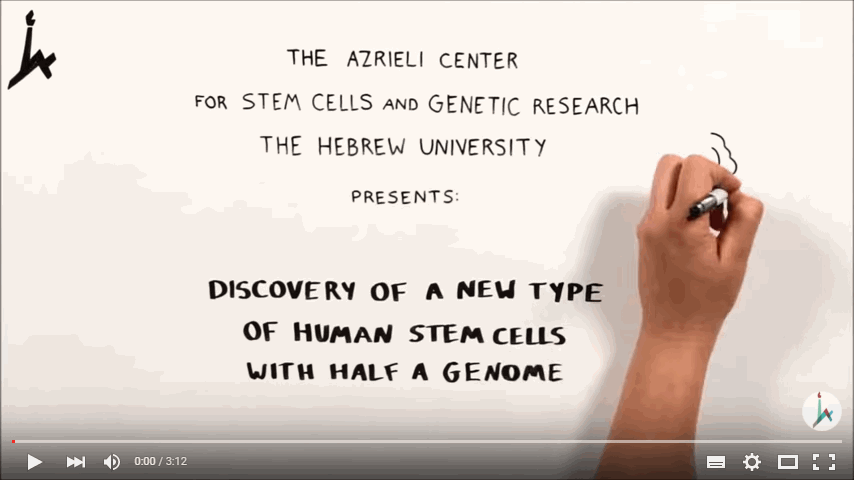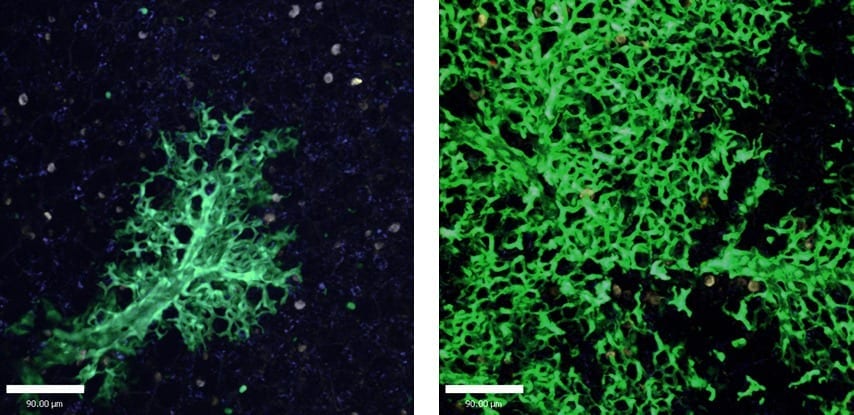
Scientists have succeeded in generating a new type of embryonic stem cell that carries a single copy of the human genome, instead of the two copies typically found in normal stem cells. These are the first human cells that are known to be capable of cell division with just one copy of the parent cell’s genome.
The scientists, from The Hebrew University of Jerusalem, Columbia University Medical Center (CUMC) and The New York Stem Cell Foundation Research Institute (NYSCF), reported their findings in the journal Nature. Since the stem cells were a genetic match to the egg cell donor, they could be used to develop cell-based therapies for diseases such as blindness, diabetes, or other conditions in which genetically identical cells offer a therapeutic advantage. Because their genetic content is equivalent to germ cells, they might also be useful for reproductive purposes.
Scientists from The Hebrew University of Jerusalem, Columbia University Medical Center (CUMC) and The New York Stem Cell Foundation Research Institute (NYSCF) have succeeded in generating a new type of embryonic stem cell that carries a single copy of the human genome, instead of the two copies typically found in normal stem cells. The scientists reported their findings today in the journal Nature.
The stem cells described in this paper are the first human cells that are known to be capable of cell division with just one copy of the parent cell’s genome.
Human cells are considered ‘diploid’ because they inherit two sets of chromosomes, 46 in total, 23 from the mother and 23 from the father. The only exceptions are reproductive (egg and sperm) cells, known as ‘haploid’ cells because they contain a single set of 23 chromosomes. These haploid cells cannot divide to make more eggs and sperm.
Previous efforts to generate embryonic stem cells using human egg cells had resulted in diploid stem cells. In this study, the scientists triggered unfertilized human egg cells into dividing. They then highlighted the DNA with a fluorescent dye and isolated the haploid stem cells, which were scattered among the more populous diploid cells.
The researchers showed that these haploid stem cells were pluripotent—meaning they were able to differentiate into many other cell types, including nerve, heart, and pancreatic cells—while retaining a single set of chromosomes.
“This study has given us a new type of human stem cell that will have an important impact on human genetic and medical research,” said Nissim Benvenisty, MD, PhD, Director of the Azrieli Center for Stem Cells and Genetic Research at the Hebrew University of Jerusalem and principal co-author of the study. “These cells will provide researchers with a novel tool for improving our understanding of human development, and the reasons why we reproduce sexually, instead of from a single parent.”
The researchers were also able to show that by virtue of having just a single copy of a gene to target, haploid human cells may constitute a powerful tool for genetic screens. Being able to affect single-copy genes in haploid human stem cells has the potential to facilitate genetic analysis in biomedical fields such as cancer research, precision and regenerative medicine.
“One of the greatest advantages of using haploid human cells is that it is much easier to edit their genes,” explained Ido Sagi, the PhD student who led the research at the Azrieli Center for Stem Cells and Genetic Research at the Hebrew University of Jerusalem. In diploid cells, detecting the biological effects of a single-copy mutation is difficult, because the other copy is normal and serves as “backup.”
Since the stem cells described in this study were a genetic match to the egg cell donor, they could also be used to develop cell-based therapies for diseases such as blindness, diabetes, or other conditions in which genetically identical cells offer a therapeutic advantage. Because their genetic content is equivalent to germ cells, they might also be useful for reproductive purposes.
“This work is an outstanding example of how collaborations between different institutions, on different continents, can solve fundamental problems in biomedicine,” said Dieter Egli, PhD, principal co-author of the study, and Assistant Professor of Developmental Cell Biology in Pediatrics at Columbia University Medical Center and a Senior Research Fellow at the NYSCF Research Institute and a NYSCF-Robertson Investigator.
Learn more: Scientists Generate a New Type of Human Stem Cell That Has Half a Genome
The Latest on: Haploid human stem cells
[google_news title=”” keyword=”haploid human stem cells” num_posts=”10″ blurb_length=”0″ show_thumb=”left”]
via Google News
The Latest on: Haploid human stem cells
- New stem cell research may have implications for liver transplantationon May 9, 2024 at 9:20 am
An alternative to whole organ transplantation is the less invasive injection of dissociated human liver cells ... Chinese Academy of Sciences in Beijing injected mouse embryonic stem cells into early ...
- Cloning 2.0: Scientists are trying to impregnate cows with stem cellson May 7, 2024 at 5:03 am
About a decade ago, biologists observed that stem cells would try to make an embryo if kept contained in an enclosed space. Also known as “embryo models” or embryoids, a lab in Israel back in 2022 ...
- Pluripotent stem cells articles from across Nature Portfolioon May 2, 2024 at 5:00 pm
Pluripotent stem cells are cells that have the capacity to self-renew by dividing and to develop into the three primary germ cell layers of the early embryo and therefore into all cells of the ...
- Stem Cells Newson April 29, 2024 at 5:00 pm
Mar. 4, 2024 — Collaborative work has developed a cell culture system that differentiates human pluripotent stem cells to amniotic ectoderm and surface ectoderm ... Human Stem Cells Coaxed to ...
- Stem Cells in Reproductive Medicineon March 6, 2024 at 2:27 pm
Check if you have access via personal or institutional login Stem cell science has the potential to impact human reproductive medicine significantly – cutting edge technologies allow the production ...
- Division and differentiation in human cellson March 26, 2023 at 7:23 pm
The nucleus of a germline stem cell undergoes two divisions, firstly separating homologous chromosomes and secondly separating chromatids. Haploid gametes contain 23 single chromosomes.
- Researchers isolate human stem cells in the labon December 8, 2021 at 12:11 am
WASHINGTON (CNN) -- Researchers have announced that they have successfully grown human stem cells in a laboratory, a major advance that could one day help in organ transplantation, gene therapy ...
- Using human stem cells to model neocortical gyration phenotypeson November 15, 2018 at 12:00 pm
Therefore, to investigate neuronal phenotypes in a human model, we developed stem cell-derived neuronal assays to assess neuron morphology as well as define the molecular disease mechanism. I will ...
- UTSA Stem Cell Coreon June 22, 2018 at 3:21 pm
Dr. Christopher Navara has 15 years of experience in pluripotent stem cell research including both humans and non-human primates. To date he has derived or isolated over 50 cell lines from rhesus ...
- FDA approves human embryonic stem cell studyon January 22, 2009 at 4:00 pm
(CNN) -- Federal regulators have cleared the way for the first human trials of human embryonic stem-cell research, authorizing researchers to test whether the cells are safe to use in spinal ...
via Bing News










